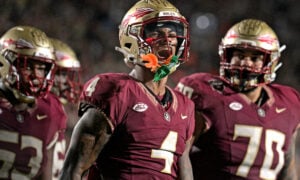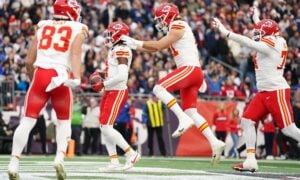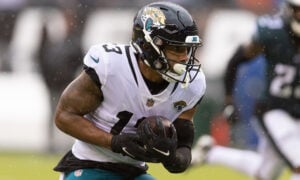Draft Decade: Tight End (Second Look)
Editor Note: This is a repost of an article posted in 2013 that is still relevant for 2014. It’s likely that two tight ends will be selected in the first round of the 2014 NFL Draft, making this information something to, once again, consider.
Each year I like to turn back the clock and review the past ten years of the NFL draft related to a particular position. Through this exercise I’m able to determine how much justifiable excitement should exist, in reality, during draft season when run-away enthusiasm often rules the day with a particular player, position or the draft in general. To a large degree, through this effort, it’s been easy to see that the NFL draft-day hype has been much more promise than production. Yet each year, we all do the same draft-day dance. And to date, I haven’t examined the tight end position to this degree.
All this said, there’s no question that the NFL draft remains an important part of augmenting your team. Whether it’s the most important part is arguable. A well prepared fantasy coach can acquire draft picks into a deep draft to bolster his/er team, or trade them away for known production into a weak draft, allowing another coach to take the risk. Every year provides different-sameness.
In past years, I’ve focused on the quarterbacks, running backs and wide receivers with some very interesting results. Quickly summarized, what I’ve found is that the top quarterback off the board is as good a bet as there is in fantasy for being a productive player. The success rate of subsequently selected quarterbacks declines quickly. The top running back selected is a 50/50 proposition and first round running backs overall, while not a great bet, do carry a much better chance of being productive than those selected outside of round one. Wide receivers? Generally, unless taken within the first five picks of the NFL draft, they bust at an extraordinarily high rate. In fact, the position is a crap shoot, even for those drafted in the first round.
I’ve even looked at the “hit” rate of fantasy drafts by pick and round, finding no surprise that a high pick in the first round is the place to be. Outside of the top pick, the success rate for a draft selection falls quickly. Middle picks in the first round are somewhat close in productivity. Second round selections hit at a rate near 15%, give or take depending on various factors including number of teams in the league, fantasy coach ability (yes this does come into play) and the depth of the NFL draft. I smell an update of these numbers coming shortly.
Today’s offering examines the tight end position. There’s little argument that the position has taken on more fantasy significance as offensive coordinators around the league try to duplicate the success of the New England Patriots within their respective systems. In short, there’s been a resurgence within the position and each year there seems to be at least a name ore two drafted very highly with the hope that they are the next Rob Gronkowski, Jimmy Graham or, veteran, Tony Gonzalez. There’s no arguing that having a top tight end can give the fantasy coach a big edge on Sundays.
As I typically do, I will be leaving out the 2013 draft class for purposes of this exercise (see editor note below). For this positional review, I am going to move away from my regular individual categorization where I normally slot players into stud, productive or bust categories toward determining from what rounds the studs are primarily drafted; few tight ends obtain stud status. It can sometimes be a tricky proposition to rank the players correctly as many will have a single year of fantasy stardom or productivity, only to fall from grace very quickly in following years. I always err on the side of “productive” in situations like this. The goal here is to show the stratification of the productive or better players from the non-productive when considering the rookie draft moreso than it is to identify the studs within a position.
Editor Note: I am adding 2013 drafted tight ends into the listing for notation but not adjusting the percentage results below due to the few names that make the list.
Let’s now take a look at the tight ends drafted from 2003-2012.
- From this period, there have been 145 tight ends drafted, an average of 14.5 per year
- There have been ten first round tight ends selected during this time frame
- There have been 17 second round tight ends during this time period
- There have been 23 third round tight ends selected during this time period
- During this decade, only years 2011 and 2012 have seen no first round tight end selection
Looking at some of the names yields some interesting trends. Please note that just because a name appears on this list does not mean that he is a productive or better player. In some cases, his current situation suggests productivity.
First Round
Tyler Eifert (2013, #21)
Jermaine Gresham (2010, #21)
Brandon Pettigrew (2009, #20)
Dustin Keller (2008, #30)
Greg Olsen (2007, #31)
Vernon Davis (2006, #6)
Marcedes Lewis (2006, #28)
Heath Miller (2005, #30)
Kellen Winslow (2004, #6)
Benjamin Watson (2004, #32)
Dallas Clark (2003, #24)
Second Round
Zach Ertz (2013, #35)
Gavin Escobar (2013, #47)
Vance McDonald (2013, #55)
Coby Fleener (2012, #34)
Kyle Rudolph (2011, #43)
Lance Kendricks (2011, #47)
Rob Gronkowski (2010, #42)
Richard Quinn (2009, #64)
John Carlson (2008, #38)
Fred Davis (2008, #48)
Martellus Bennett (2008, #61)
Zach Miller (2007, #38)
Joe Klopfenstein (2006, #46)
Anthony Fasano (2006, #53)
Tony Scheffler (2006, #61)
Ben Troupe (2004, #40)
Kris Wilson (2004, #61)
Bennie Joppru (2003, #41)
L.J. Smith (2003, #61)
Teyo Johnson (2003, #63)
Third Round (Noteworthy Only)
Jordan Reed (2013, #85)
Dwayne Allen (2012, #64)
Ed Dickson (2010, #70)
Tony Moeaki (2010, #93)
Jimmy Graham (2010, #95)
Jared Cook (2009, #89)
Jermichael Finley (2008, #91)
Chris Cooley (2004, #81)
Jason Witten (2003, #69)
Visanthe Shiancoe (2003, #91)
Fourth Round (Noteworthy Only)
Aaron Hernandez (2010, #113)
Dennis Pitta (2010, #114)
Owen Daniels (2006, #98)
Rounds 5-7 Notables (Round)
Mychal Rivera (6)
Brandon Meyers (6)
Brent Celek (5)
Points of interest from this breakdown:
- Ten (100%) of first round tight ends have been at least productive players
- Six (35.3%) of 17 second round tight ends have been productive or better players
- Six (26.1%) of 23 third round tight ends have been productive or better players
- Three (13.6%) of 22 fourth round tight ends have been productive or better players
- Two (2.7%) of 73 tight ends selected after round four were productive
- 26 (17.9%) of drafted tight ends have been at least productive
Given this breakdown of the tight end position as related to their drafted selection, there are a number of ‘safe’ take-aways that prospective drafters can use toward evaluating rookies within the position. Even young non-rookie tight ends will likely trend to these numbers, allowing a fantasy coach to target poor performing first-year players with the hope that they will eventually realize their potential.
- More than any position reviewed previously, the tight end yields the safest first round selection results. If you have a need at the position, draft with confidence
- Stud tight ends are distributed rather evenly over the first three rounds of the NFL draft
- With a 35.3% productivity rate for second round NFL drafted tight ends, it’s an adequate risk-reward play in the second round of rookie drafts
- With a 26.1% productivity rate for third round NFL Drafted tight ends, it’s an adequate risk-reward play in the late-third and fourth rounds of your rookie draft
- Selecting any rookie tight end highly after NFL draft round three is a fool’s folly
I have to admit, this exercise was eye opening on many levels. In no way did I expect that production of NFL first round drafted tight ends would be nearly guaranteed, at least over the past decade. In most all cases, the better teams in your fantasy draft will be drafting at or near the bottom of round one. While, normally, the ‘hit’ rate of rookie players descends quickly from picks at the top of round one, one could argue that a strong team’s best move may be a selection of a NFL first round drafted tight end, due to the propensity of the player to be productive. It’s not uncommon for fantasy rookie selections to bust at a rate of 80% entering the second round in fantasy. A shrewd fantasy coach may wish to play the odds here and I wouldn’t blame him.
I hope you’ve enjoyed this introspection of rookie tight ends and are able to use the information in future drafts.
Follow me on Twitter: @DLF_Jeff
- Lineup Advice: Wrap-up, Thank You and Goodbye (TTFN) - January 1, 2024
- Lineup Advice: Week 17 – Championship Edition - December 26, 2023
- Lineup Advice: Week 16 – The “What is” Edition - December 19, 2023


































































